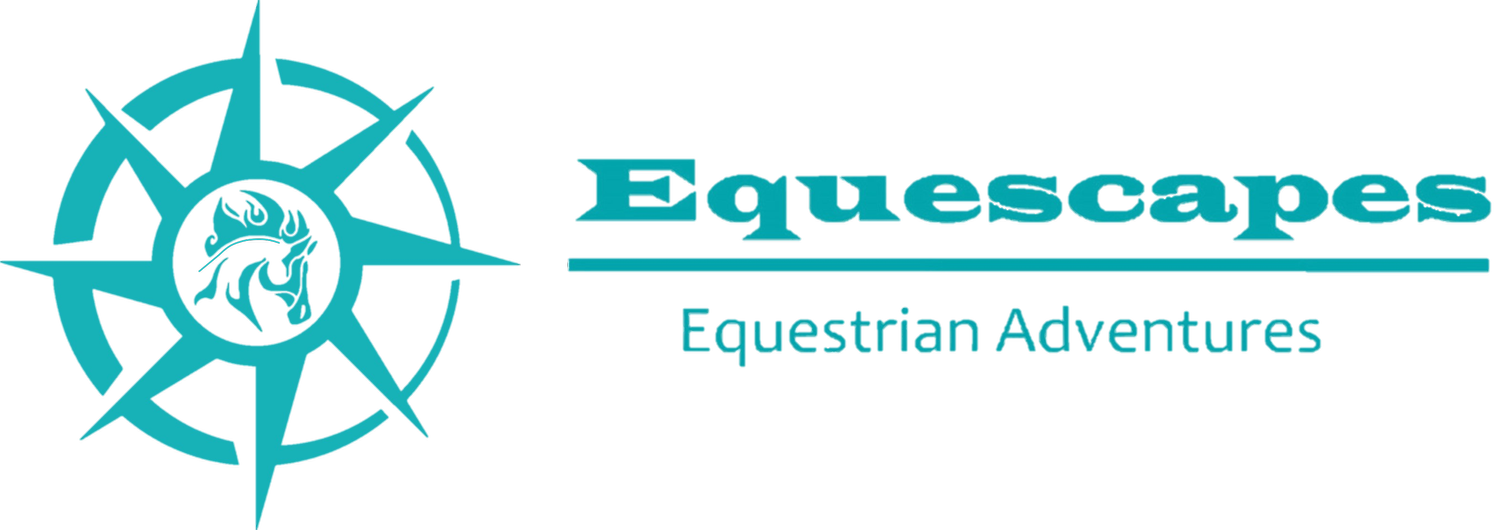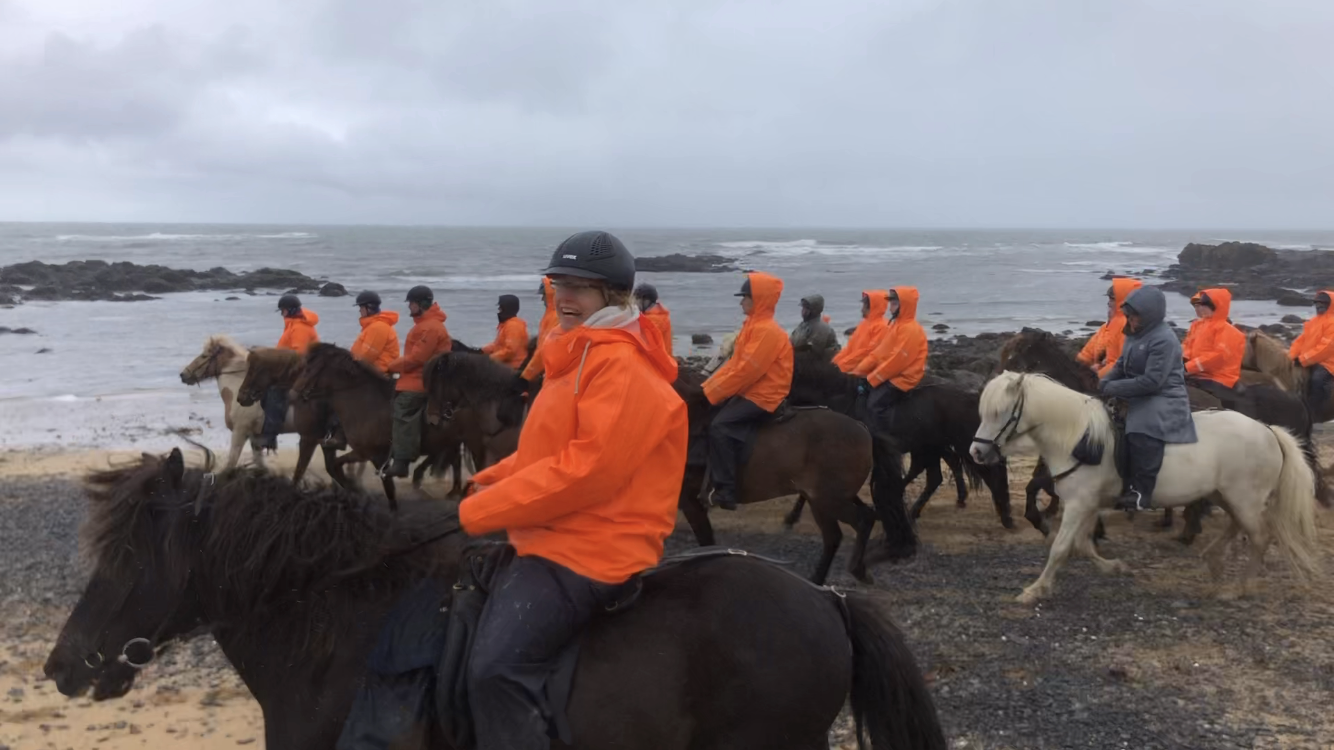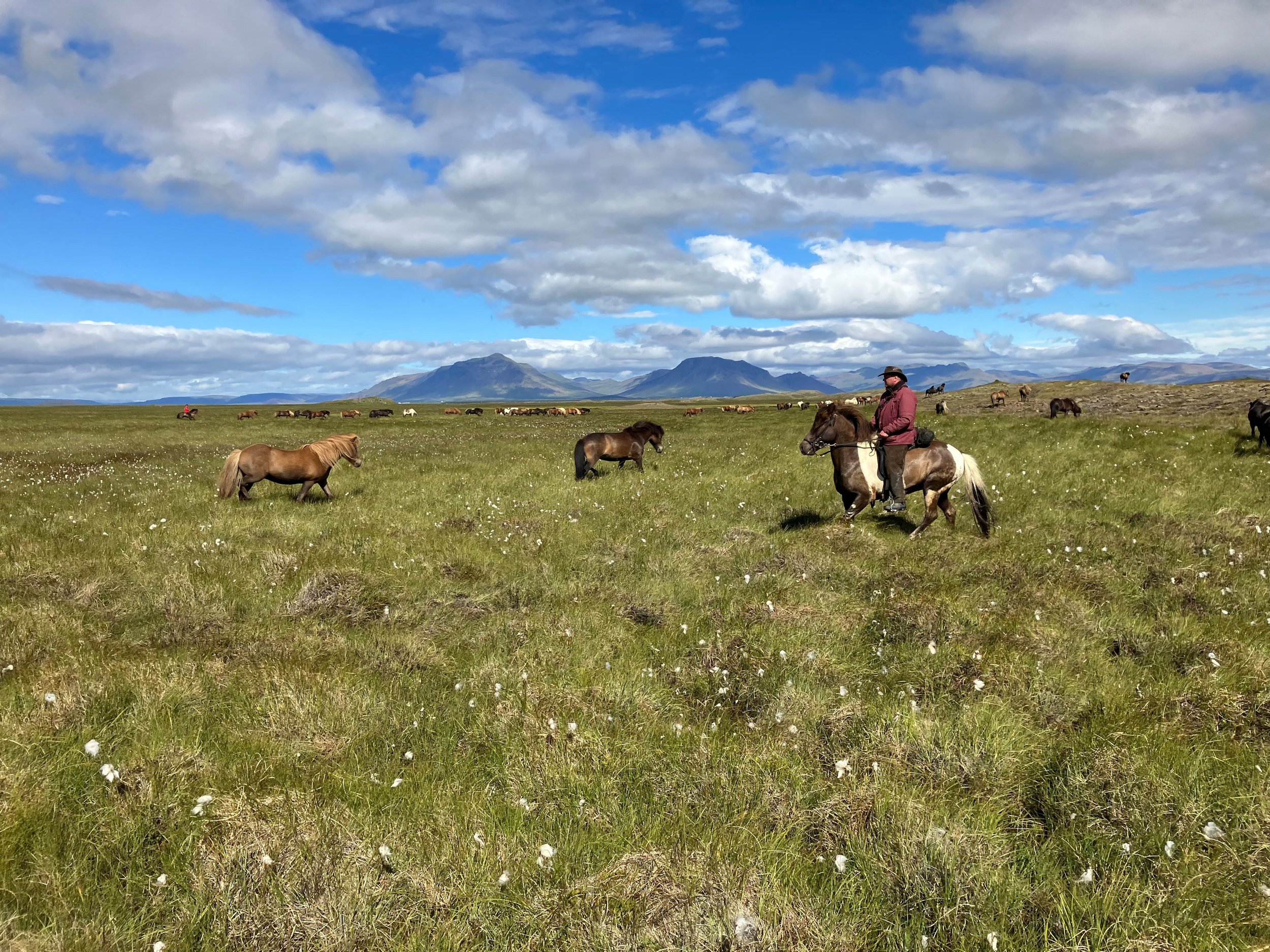An orchestra of a thousand hoof beats rings out across the black sand. The arctic wind plays the violin, the distant crashing waves the bass. The melody reaches a crescendo each time the horses plunge through the frigid water, splashing and thundering, and then plays pianissimo when we re-emerge onto the sand, hooves pitter-pattering as if on tip-toe.
To our left, the backdrop curtain - emerald green growing up the steep sides of ancient volcanoes, darkening clouds building behind them. To our right, a vast expanse of open beach. The tide is out, leaving pools and rivulets of water dark as ink and mud like wet cement. The rest is sand, black from volcanic ash, churned by the hundred horses in front of us.
Stori-Kalfalækur Farm, our home for the week
We are on the home stretch, the last day of a 6-day horseback trek around Iceland’s Snæfellsnes Peninsula. 20 riders from all over the world come together here, staying on a quaint family farm where we begin as strangers and leave as friends.
From the farm we’ve ridden up into the mountains, through the lava fields, across estuaries, and we now return along the beach. There are 25 of us - 20 guests and 5 Icelandic guides and horsemen, and 90-100 horses. The horses who aren’t under saddle at any given time run in a loose herd with the guides at the front and our group of riders bringing up the rear, herding them along.
Each day we cover 15-20 miles, and each night the herd sleeps in a farmer’s field somewhere and we return to the farmhouse, the family home of Siggi and Olafe. We swap horses when we stop for lunch each day - sandwiches we pack each morning, eaten sitting on the ground, while the horses graze until it’s time to saddle up again.
The tack here takes some getting used to - not the saddles themselves, which are similar to Dressage saddles and more or less as comfortable. Each rider has a saddle for the week, which we move to each horse as we draw them. We ride without any kind of saddle pads, which seems like it should be problematic with the amount of mud and sand that inevitably gets caked on the saddles and girths. Yet none of the horses seem to show any discomfort, and none have sores or scars from ill-fitting tack. They ride with cruppers to prevent tack from slipping forward, and the rule of thumb is, if you can mount from the ground without moving your saddle, it’s tight enough.
Manes for days
Each horse has a snaffle bridle, which is used to catch it, and then a noseband which fits over. This is assigned to each rider with their saddle, and heaven forbid you lose your noseband. This is the number one rule for the week - keep track of your noseband! No one has yet discovered what the consequence is for failing to do so.
The horses are no more bothered by the tack as by the treacherous terrain - uneven ground of lava formations and round, grassy hummocks and hillocks. Even the fields that look flat are anything but. The horses just tölt right over it like it’s nothing, hooves clattering in unison as we rumble right along.
The tölt is unique to the Icelandic horse - a unique four-beat lateral gait that the breed is best known for. It is similar to a running walk, with the horse's hind legs moving under the body to carry more of the weight, allowing the front to rise and be free and fluid. The knees come up high to go over the uneven ground, which is how the breed developed this gait in the first place. The Icelandic horse has a gene mutation which synchronizes the left and right sides of the horse’s body, which allows gaited breeds to do what they do.
Some horses tölt easily and some would rather trot or pace, which is far less comfortable. A horse comfortably tölting along feels like driving on the rumble strips on the edge of the road, and is sure to bring a smile, maybe even a giggle.
All smiles and sunshine on Day 1
Smiles were as bright as the sunshine on our first day, as we shed layers along with preconceptions of what the ride might entail. The first ride is an ice-breaker, between guests and between rider and horse, as we learn what the Icelandic horse is all about. Some of our riders have ridden Icelandics before, here in Iceland or elsewhere, but that never makes the first ride here any less exciting.
As the landscape becomes more dramatic over the course of the week, so does the weather. Moody fog swirls and dark clouds hover ominously in the distance. Kitted out in borrowed rain gear, we look like orange traffic cones, and when we stop for lunch in the rain we huddle like penguins.
Matching traffic-cone-orange rain ponchos
Trailing the herd across the estuary in the rain feels like we are herding them right out to sea. Chest-deep water, despite the low tide, seeps into our boots and splashes every which way, and the fog has obscured the coastline completely. Our guides deftly navigate the sand bars to keep us where the horses’ hooves can at least touch the bottom - we are literally riding along the bottom of the ocean, and between the splashing and the rain, we might as well be actually riding under water. To afraid to take out phones and cameras, most of the day’s ride goes undocumented - each and every one of us is fully present in the moment. Chilly and wet though we may be, the experience of riding the horses into the sea is mesmerizing, leaving us in wonder and amazement.
Our stops and lunch break find most of us soaked and shivering, a little apprehensive about the miles we have still to go, but the hardship of the cold creates the kinds of travel bonds that will long outlast the trip. Riders share snacks, layers, and words of encouragement, huddled together against the wind.
The quintessential Icelandic cowboy/farmer/guide
Later, in dry layers (with wet clothing hanging from every possible surface of the farmhouse), we eat lamb stew and sing along with our guides in English, Icelandic, and German, voices united in joy at having survived to ride another day.
By the final day, the sun has reemerged, and the beach and bay we traveled across in the fog is now revealed to us. The water isn’t as deep - the rivers running into the estuary have receded, and subsequently so has the tide. Snæfellsjökull Glacier glistens atop the distant peaks, the sea glitters, and the soft sand sets the stage for the music of a thousand hooves, a melody to be remembered and replayed, perhaps repeated - though the tune is never quite the same twice, for each trek is exceptional and unique in its own way, enriched by the flavors of each rider, each group, and each and every incredible moment in time aboard these marvelous horses.







